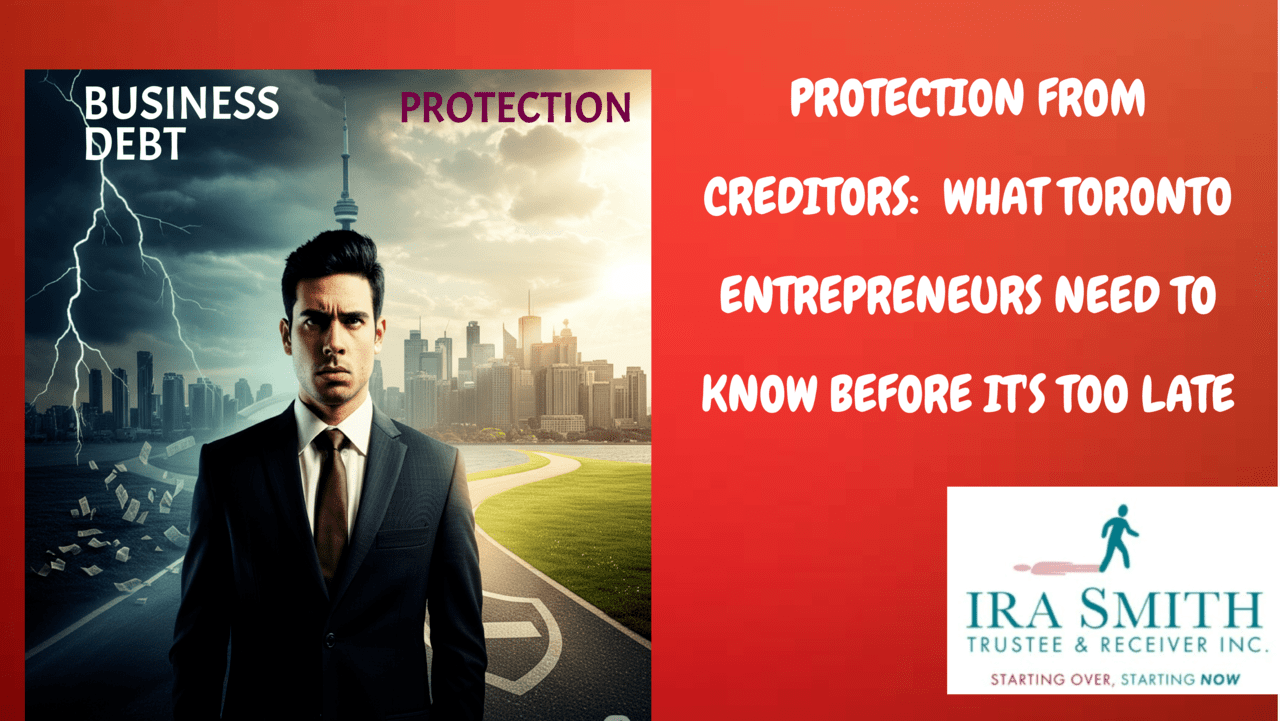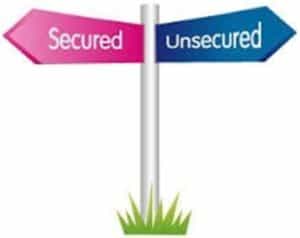protection from creditors
Protection From Creditors: The Real Problem Toronto Business Owners Face
I need to start by reminding you that I am a licensed insolvency trustee, not a lawyer. This Brandon’s Blog on protection from creditors is not about how to hide your assets from creditors when financial trouble looms. It is also not legal advice. For that, you need to see your lawyer.
Rather, this is for informational purposes about the realization that pretty much every Toronto entrepreneur risks losing their assets to business debt. This Brandon’s Blog is meant to provide practical steps to gain protection from creditors for your personal assets while resolving business financial troubles from a licensed insolvency trustee with many success stories.
Meet Carlos. He started a food truck in Toronto selling arepas in 2022. By 2024, food costs doubled, and he took out a $100,000 loan using his North York home and his food truck as collateral. Now, he’s three months behind on payments. The bank wants his business AND his house.
Carlos isn’t alone. Nearly 3 out of 4 small business owners in Ontario lose sleep over mixed personal and business debts. With consumer debt hitting record highs and business bankruptcies up almost 18% in Ontario last year, keeping your business problems from becoming problems for your personal financial affairs is crucial.
Protection From Creditors: Why Your Business Debt Becomes Personal -Three Common Traps
Trap #1: Using Personal Credit Cards for Business
“I just needed to buy supplies quickly.”
The hard truth: When you swipe your card for business expenses, you’re personally responsible for that debt. 68% of new businesses use personal credit.
Trap #2: Signing Personal Guarantees
“The bank said I had to sign my name to get the loan.”
The hard truth: Almost all Canadian small business loans (92%) require personal guarantees. Last year, a Mississauga contractor lost his heavily mortgaged home because he guaranteed a $350,000 equipment loan he could not repay.
Trap #3: Mixing Money
“I don’t have time to keep everything separate.”
The hard truth: When your personal and business money flows through the same accounts, you’re asking for trouble. Almost 9 out of 10 bankruptcy cases get more complicated and expensive because of mixed finances.

Four Ways Toronto Entrepreneurs Can Get Protection From Creditors
Option 1: Creditor Protection Through Business Restructuring (For Incorporated Companies)
This uses Canada’s Companies’ Creditors Arrangement Act (CCAA) or the restructuring provisions of the Bankruptcy and Insolvency Act (BIA) to:
- Keep your business running while you work out new payment terms
- Shield your personal stuff from business creditors
Real example: A restaurant group kept six locations open through this process last year.
Good points:
- Protects your personal assets
- Keeps your employees working
Not-so-good points:
- CCAA only works for bigger companies ($5+ million in debt) and is court-driven and therefore very expensive.
- For companies that owe less than $5 million, the restructuring provisions of the BIA are available and is a less costly process than the CCAA. Technically, nothing is stopping a debtor that qualifies under the CCAA to use the BIA instead.
- Takes 6-18 months to complete
Option 2: Consumer Proposal (Perfect for Many Small Unincorporated Business Owners)
A consumer proposal can legally:
- Cut up to 80% off your total debt
- Let you keep your assets if completed successfully
- Stop collection calls, lawsuits, and bank account seizures immediately
Real example: A Scarborough sole proprietor cut $150,000 in mixed debts down to $30,000 through a consumer proposal.
- Meet with a licensed insolvency trustee (free first meeting)
- File paperwork under the BIA
- Make one affordable monthly payment for up to 5 years that your unsecured creditors have agreed to either at a meeting of creditors (if required) or having agreed in advance, and therefore no meeting is necessary
Option 3: Strategic Personal Bankruptcy
Sometimes starting fresh makes the most sense, especially when:
- Your business can’t be saved
- You need immediate relief from overwhelming debt
- You don’t own any or many assets
What Can You Keep? Ontario’s 2025 Bankruptcy Exemptions
When dealing with serious debt problems, many Toronto entrepreneurs worry they’ll lose everything. Good news – Ontario law lets you keep certain things even during bankruptcy or proposals.
Your Home
You can keep your home if: You have $10,783 or less in equity (that’s your home’s value minus what you still owe on your mortgage).
You might lose your home if: Your equity is higher than $10,783. In that case, the trustee might sell your home to pay creditors, but you’d still get the first $10,783.
What Else Can You Keep?
Household Items: Furniture, appliances, dishes, and food up to $14,180
Work Tools: Equipment you need for your job or business up to $14,450
Your Car: One vehicle worth up to $6,600
Clothes: All your necessary clothing, no dollar limit
Retirement Savings: Most RRSPs are protected (except money you put in during the 12 months before filing)
Life Insurance: Many policies are protected from creditors
For Farmers: Special protections for livestock, equipment, and tools up to $31,379
Real-World Example: I will call this woman Samira. When Samira, a Toronto web designer, filed for bankruptcy, she kept her car valued at $5,000, her computer equipment (valued at $8,000), and her condo (because her equity was only $9,000). This gave her the fresh start she needed without losing essential assets. She still had lots of secured debt, which is another issue, but she did not have to give up those assets.
Note: These exemption numbers can change yearly with regulations. Always check with a licensed insolvency trustee for the most current exemption amounts.
Option 4: Debt Consolidation (The 2025 Method)
Many Toronto entrepreneurs are now:
- Working with alternative lenders to the big banks, such as credit unions
- If of sufficient value, using business equipment as collateral instead of their homes
Warning: Be careful with this option. Nearly half of consolidated debts end up in default within two years.
Get Protection From Creditors Today: The One-Hour Checklist
Step 1: Separate Your Money (This Afternoon)
- Open business accounts at a different bank from your personal accounts
- Stop using credit cards that you cannot afford to pay off monthly for business expenses
- Set up automatic transfers for your business’s “salary”
Step 2: Document Everything (This Evening)
- Take photos of all business equipment
- Make copies of all loan agreements
- Create a list of who you owe money to (both business and personal)
Step 3: Get Help (This Week)
- Contact the Ontario Business Legal Clinic for free advice
- Visit Toronto’s Office of Financial Empowerment
- Calculate your business debt ratio (Total Debts ÷ Total Assets)

protection from creditors
Protection From Creditors: Real Toronto Success Stories
The Tech Startup That Bounced Back
Problem: A Markham software company owed $2.3 million to creditors, both secured creditors and unsecured creditors. The founder had used his $900,000 condo as loan collateral.
Solution: Through a court-supervised restructuring, the company cut their debt by 60%. Today, they’re profitable and employ 12 people.
The Food Truck Owner Who Saved His Home
Problem: Carlos (from our opening story) had $230,000 in combined debt. The CRA was about to garnish his income.
Solution: Through a consumer proposal, he reduced his unsecured debt to $30,000 and will be paying it off over five years ($500 monthly). He can pay that along with his bank loan payments and therefore keep his home and his food truck.
Protection From Creditors: Three Things To Do Before Friday
- Download our free worksheet: “Toronto Debt Relief Worksheet“. Fill out all the requested information. Warning: it asks for a lot of information because it aims to look at every important aspect of your financial situation.
- Review carefully all the information you filled in: If you were honest and completed the whole worksheet, the issues you need to work on will jump right off the page at you.
- Book your free consultation: If the worksheet highlights issues you don’t know what the best solution would be to fix them, contact us for a no-cost consultation.

protection from creditors
Top Questions Toronto Business Owners Ask About Debt Protection From Creditors
Q: Why should I worry about separating business and personal debt?
A: Almost 60% of Toronto entrepreneurs end up losing personal assets because of business debts. With business bankruptcies up 17.8% in Ontario last year and consumer debt hitting record highs, keeping these separate isn’t just smart—it’s survival. Many of my clients couldn’t sleep at night until they protected their personal finances from business troubles.
Q: Can the CRA take my house for business taxes?
A: Yes, if:
- Your business is incorporated but has unpaid employee source deductions or outstanding HST. That is a personal liability of all directors, notwithstanding your business is run by a separate legal entity.
- You operate your business as a proprietorship or partnership. In those situations, your business debts are also your personal debts.
We helped several Toronto families keep their homes from CRA collection last year alone. The CRA has stronger collection powers than most creditors and can place liens on your property for unpaid taxes.
Q: My business is incorporated—doesn’t that protect me automatically?
A: This is a dangerous myth I see hurting Toronto entrepreneurs. Incorporation only protects you if you never personally guaranteed any loans or credit cards. The truth? About 92% of Canadian small business loans require personal guarantees, which means your home and savings are still at risk.
Q: How fast can I stop collection actions?
A: As soon as you do an insolvency filing. It is something called the “stay of proceedings” that kicks in. This legally stops all collection efforts immediately, usually within 5-7 days of your first meeting with a licensed insolvency trustee. Last month, we helped a restaurant owner stop garnishment actions that were just 48 hours away from freezing her accounts.
Q: How do I know if I’ve fallen into the “mixed finances trap”?
A: Check these warning signs: Do you use the same credit card for groceries and business supplies? Is your business operating account at the same bank as your personal chequing account? Have you ever transferred money between personal and business accounts without proper documentation? If you answered yes to any of these, you need to take action immediately.
Q: What’s better for a small business owner—bankruptcy or consumer proposal?
A: For most Toronto entrepreneurs I work with, either a consumer proposal or a BIA restructuring proposal (for those who owe more than the consumer proposal limit of creditors in excess of $250,000, not including any debts secured against your home) offers a better alternative. You can keep your assets (including your home), reduce unsecured debts by up to 75%, and rebuild your credit faster. Bankruptcy should be your last resort, though it works well when you need immediate relief and don’t have significant assets to protect.
Q: How do I know which debts are dischargeable in bankruptcy?
A: Most business and personal unsecured debts can be eliminated through bankruptcy, including credit cards, lines of credit, and supplier accounts. However, some debts survive bankruptcy, including student loans less than seven years since you stopped being a student, court fines, and child support. I recommend bringing a complete list of your debts to your consultation for a personalized assessment.
Protection From Creditors Conclusion
I hope you’ve found this protection from creditors Brandon’s Blog, helpful. There is a lot of uncertainty in business today. The time to properly plan to gain asset protection from creditors is when you begin your business. Once your business is in financial trouble, it is too late.
If you or someone you know is struggling with too much debt, remember that the financial restructuring process, while complex, offers viable solutions with the right guidance. As a licensed insolvency trustee serving the Greater Toronto Area, I help entrepreneurs understand their options and find a path forward during financial challenges.
At the Ira Smith Team, we understand the financial and emotional components of debt struggles. We’ve seen how traditional approaches often fall short in today’s economic environment, so we focus on modern debt relief options that can help you avoid bankruptcy while still achieving financial freedom.
The stress of financial challenges can be overwhelming. We take the time to understand your unique situation and develop customized strategies that address both your financial needs and emotional well-being. There’s no “one-size-fits-all” approach here—your financial solution should be as unique as the challenges you’re facing.
If any of this sounds familiar and you’re serious about finding a solution, reach out to the Ira Smith Trustee & Receiver Inc. team today for a free consultation. We’re committed to helping you or your company get back on the road to healthy, stress-free operations and recover from financial difficulties. Starting Over, Starting Now.
The information provided in this blog is intended for educational purposes only. It is not intended to constitute legal, financial, or professional advice. Readers are encouraged to seek professional advice regarding their specific situations. The content should not be relied upon as a substitute for professional guidance or consultation. The author, Ira Smith Trustee & Receiver Inc., and any contributors do not assume any liability for any loss or damage.



